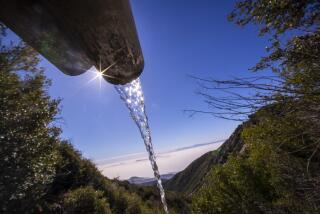Water Board Fines 2 Polluting Firms for 1st Time in 35 Years
- Share via
Apparently for the first time in its 35-year history, the environmental agency that enforces federal and state water-pollution control laws in San Diego and parts of Orange and Riverside counties has fined a polluter.
The California Regional Water Quality Control Board’s San Diego region on Monday fined a metal-milling firm $11,891.72 for discharging hazardous wastes into Chollas Creek, and a sand-processing firm $3,809 for releasing waste water into the San Luis Rey River.
The fines represented the first application of a 9-month-old state law that enabled the board to levy fines after an administrative hearing, rather than having to resort to time-consuming legal proceedings in court.
“We think it’ll make the regulated community more responsive to the requirements that are imposed on them in their waste-discharge permits,” said David Barker, an engineer with the regional office. “I think the public will be better served.”
The larger fine--against California Creative Dynamics Inc. for allowing highly alkaline wastes into Chollas Creek last spring--represented the administrative costs to the regulatory agencies that investigated the incident and oversaw the cleanup, Barker said.
The smaller fine--against Marron Brothers Inc. for allowing turbid waste water into the San Luis Rey River last spring--represented the agencies’ administrative costs as well as about $1,200 in punitive damages, Barker said.
“It’s kind of the equivalent of a traffic ticket,” said Arthur Coe, the supervising engineer in the board’s regional office. “It’s something that the regional board can issue directly and if the person pays the fine, that ends it right there.”
Marron Brothers, which mines sand from the river to sell for construction projects, intends to pay the fine, general manager Sonny Dominguez said. Officials from California Creative Dynamics could not be reached, but Barker said the firm intends to pay its fine in installments.
The regional board, created in 1950, has had the power to go to court to levy fines since the early 1970s, Coe said. But he and Barker said the agency got faster results by working with polluters and using other enforcement tools to get compliance.
For example, Coe said the board could force municipalities into compliance by threatening to bar new connections to sewer systems--the equivalent of a building ban. It could also prohibit an industrial discharge--a power that could put some firms out of business, he said.
But he also said, “From our point of view, there are many types of potential enforcement actions that over the years have either been held back or deferred because the magnitude of the problem did not warrant all the rigamarole of going through the attorney general’s office.”
In one case, efforts to clean up an illegal dump took six years in court, he said.
Late last year, the state Legislature passed a law that expanded the powers of regional boards statewide and allowed them to impose fines directly. Since then, Coe said, other boards have found the new power effective.
Coe and Barker knew of no time in the history of their office that it had imposed a fine, through the courts or otherwise.
Marron Brothers, which uses river water to clean the sand, discharged wastewater back into the river in violation of its permit, Barker said. The company should have been leaving the water in pools until the sediment settled, then recycled it, Barker said.
Dominguez said a construction boom had created an unanticipated demand for sand, so the pools had been filled and were overflowing into the river. Since then, he said, the company has spent $29,000 to expand its holding pools.
California Creative Dynamics cleaned up a three-mile stretch of Chollas Creek after the discharge in March and April, officials have said. The district attorney’s office issued a felony complaint last month charging two officials with illegal disposal of hazardous wastes.
The officials have pleaded innocent.
Barker said California Creative Dynamics was fined only for the regulatory agencies’ administrative costs because there was no environmental damage. But a board environmental quality specialist said last month that pH levels in parts of the creek were near 14 in April, the highest alkaline levels measurable, and fatal to plants and wildlife.
More to Read
Sign up for Essential California
The most important California stories and recommendations in your inbox every morning.
You may occasionally receive promotional content from the Los Angeles Times.













